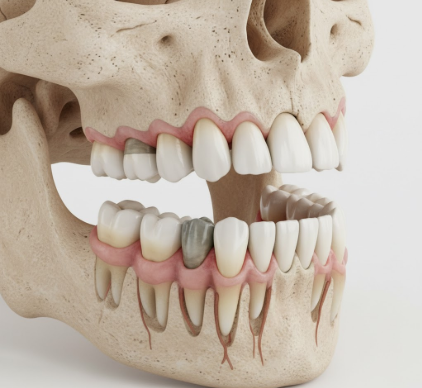Ah, wisdom teeth. Those mysterious molars that make their grand entrance often long after the rest of our pearly whites have settled in. Officially known as third molars, they are the last teeth to erupt, typically making an appearance sometime between the ages of 17 and 25. This timing, coinciding with the period when a young person is traditionally thought to be gaining maturity and, well, wisdom, is how they earned their rather thoughtful name. But beyond the moniker, what are they really, and why do we even have these latecomers to our dental party?
Our Ancient Inheritance: The Original Purpose of Wisdom Teeth
To understand why wisdom teeth exist, we need to take a little trip back in time, way back, to our early human ancestors. Imagine a diet vastly different from the processed, cooked, and often soft foods many of us consume today. Our predecessors were munching on some pretty tough stuff: raw plants, fibrous roots, nuts, and uncooked meats. This kind of diet required serious chewing power and put a lot of wear and tear on their teeth.
Consequently, early humans had larger, more robust jaws than we do. These more spacious jaws comfortably accommodated an extra set of molars at the back. The wisdom teeth, or third molars, were incredibly useful. Think of them as nature’s reserve grinders. As other molars wore down from the constant grinding of coarse food, or were perhaps lost due to lack of dental hygiene (no toothbrushes back then!), the wisdom teeth would emerge and provide fresh chewing surfaces. They were essential for survival, ensuring our ancestors could continue to process the nutrients from their challenging diet throughout their lives.
These teeth also likely helped with the sheer volume of chewing required. Processing tough, uncooked vegetation and meat wasn’t a quick affair. Having more grinding surfaces meant more efficient breakdown of food, which was crucial for extracting enough calories and nutrients. So, in essence, wisdom teeth were a vital part of an ancient dental toolkit, perfectly adapted to the lifestyle and dietary needs of early humans.
The Evolutionary Shift: Smaller Jaws, Lingering Teeth
Fast forward thousands of years. Human evolution has brought about significant changes. One of the most notable in this context is the development of agriculture and the invention of cooking. Our diets became softer and easier to chew. We started processing grains, cooking meats until tender, and generally consuming foods that didn’t demand the same level of aggressive mastication.
This dietary shift had a direct impact on our physiology. With less need for powerful chewing, human jaws gradually became smaller. This is a common evolutionary trend: structures that are no longer critical for survival or function may reduce in size or prominence over generations. However, the blueprint for our teeth, including the third molars, didn’t shrink at the same rate. The result? We often end up with a modern jaw that simply doesn’t have enough room for these last-arriving teeth. It’s like trying to fit an extra piece of furniture into an already full room.
This mismatch between tooth size and jaw size is the primary reason why wisdom teeth have become a common topic of discussion in dental offices today. They are often seen as vestigial structures, meaning they are remnants of organs or features that had a significant function in our ancestors but have less or no discernible function in their current form. While they can still contribute to chewing if they erupt correctly, their original vital role has largely diminished due to our changed lifestyles and diets.
When Wisdom Teeth Become Problematic
For many people, the arrival of wisdom teeth isn’t a smooth process. Because our jaws are often too small to accommodate them, these third molars can run into a host of issues. The most common problem is
impaction. An impacted wisdom tooth is one that is blocked or prevented from fully erupting into its normal position. This blockage can be caused by adjacent teeth, overlying bone, or dense gum tissue.
There are several ways a wisdom tooth can be impacted:
- Mesial impaction: This is the most common type, where the tooth is angled forward, towards the front of the mouth, pushing against the second molar.
- Vertical impaction: The tooth is in a relatively normal upright position but still trapped beneath the gum or bone.
- Horizontal impaction: The tooth is lying completely on its side, often pressing horizontally into the roots of the second molar.
- Distal impaction: The tooth is angled backward, towards the rear of the mouth. This type is less common.
Impacted wisdom teeth aren’t just a matter of a tooth being stuck; they can lead to a cascade of other dental concerns. Because they are often difficult to clean, partially erupted or impacted wisdom teeth can become breeding grounds for bacteria. This can lead to tooth decay not only in the wisdom tooth itself but also in the neighboring second molar, which is often hard to reach with a toothbrush and floss when a wisdom tooth is awkwardly positioned.
Beyond Impaction: Other Potential Issues
Even if a wisdom tooth isn’t fully impacted, its presence can cause trouble.
Pericoronitis is a common inflammation and infection of the gum tissue around a partially erupted wisdom tooth. Food particles and bacteria get trapped under the flap of gum (called an operculum) overlying the tooth, leading to pain, swelling, a bad taste or smell, and sometimes difficulty opening the jaw. This condition can be quite uncomfortable and may require antibiotics or minor surgical procedures to clean the area or remove the gum flap.
In some cases, a fluid-filled sac called a
cyst or, rarely, a tumor can develop around an impacted wisdom tooth. While often benign, these cysts can grow and damage the jawbone, adjacent teeth, and nearby nerves if left untreated. This is one of the reasons dentists often monitor impacted wisdom teeth even if they aren’t causing immediate pain.
Overcrowding is another concern. As wisdom teeth try to force their way into a jaw that doesn’t have enough space, they can exert pressure on the teeth in front of them. While the extent to which wisdom teeth cause significant crowding of front teeth is debated among dental professionals, it’s a potential issue that is often considered, particularly if someone has undergone orthodontic treatment to straighten their teeth.
Impacted or poorly positioned wisdom teeth can be tricky. They often create areas that are very difficult to clean, leading to a higher risk of decay and gum inflammation not just for the wisdom tooth itself, but also for the important second molar right next to it. If you experience persistent pain, swelling, or notice a bad taste near your back teeth, it’s a good idea to consult a dental professional to see what’s going on.
To Keep or Not To Keep: The Modern Dilemma
So, given their ancient origins and modern potential for problems, do all wisdom teeth need to be removed? The simple answer is no, not necessarily. If wisdom teeth erupt fully, are correctly aligned, healthy, and can be properly cleaned as part of a daily oral hygiene routine, they may not cause any issues and can remain in the mouth as functional teeth. Some lucky individuals have enough jaw space for their wisdom teeth to come in without a hitch.
The decision about whether to remove wisdom teeth is usually made on a case-by-case basis, often after a dental examination that includes X-rays to assess their position and development. A dentist will consider several factors:
- Are they causing pain or infection? Current problems are a strong indicator for removal.
- Are they impacted in a way that is likely to cause future problems? This might include potential damage to adjacent teeth, risk of cyst formation, or recurrent pericoronitis.
- Can they be effectively cleaned? If their position makes good hygiene impossible, they are at high risk for decay and gum disease.
- Is there enough room for them? If not, they may contribute to crowding or other alignment issues.
- The patient’s age and overall health: Younger patients often recover more quickly from wisdom tooth extraction, which can be a factor in prophylactic (preventative) removal.
In many instances, dentists may recommend removing wisdom teeth proactively, even before they cause obvious symptoms, if X-rays and clinical examination suggest a high likelihood of future complications. This is often done to prevent more serious problems down the line, which can be more difficult to treat, especially as a person gets older and healing may be slower.
Living With Your Wisdom (Teeth)
If your wisdom teeth are healthy and well-aligned, consider yourself fortunate! They can serve as perfectly good molars. The key is maintaining excellent oral hygiene, ensuring you can reach all the way back to clean them thoroughly. Regular dental check-ups are also crucial, as your dentist can monitor them for any signs of trouble.
For those who have had them removed, or are facing the prospect, it’s simply a modern adaptation to our evolutionary journey. Our lifestyles changed, our jaws adapted, and sometimes, these last molars just don’t fit into the contemporary oral landscape. Understanding their history, from essential tools for our ancestors to common sources of dental procedures today, gives us a fascinating glimpse into how humans have evolved. They are a reminder that our bodies carry legacies from a very different past, and sometimes, a little intervention is needed to keep us comfortable and healthy in the present day.
Ultimately, wisdom teeth are a unique part of our dental anatomy with a rich evolutionary story. Whether they stay or go, their tale is intertwined with our own human journey. Their “wisdom” might not be in the knowledge they impart, but in the lessons they teach us about our own biological history and the ongoing process of adaptation.









